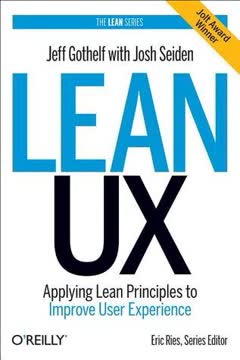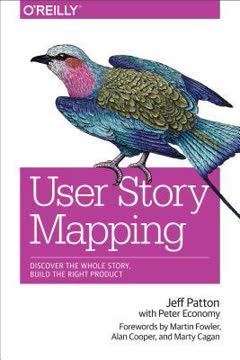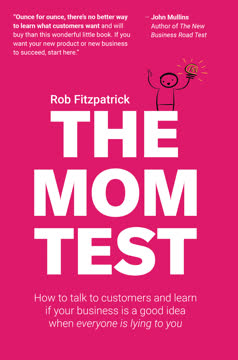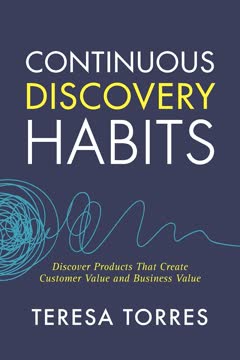つの重要なポイント
1. 継続的な発見:顧客が求める製品を作るための鍵
製品を開発するチームが、少なくとも週に一度は顧客と接触し、望ましい結果を追求するための小規模な調査活動を行うこと。
継続的な発見とは、顧客調査と実験を継続的に行う構造化された製品開発アプローチです。これにより、チームは以下の方法で一貫して価値を提供できます:
- 顧客と毎週関わり、彼らの進化するニーズを理解する
- 大規模で頻度の低い調査ではなく、小規模で頻度の高い調査活動を行う
- 単に機能を出荷するのではなく、明確な望ましい結果を追求する
- 製品チーム全体(プロダクトマネージャー、デザイナー、エンジニア)を顧客調査に参加させる
このアプローチにより、チームは顧客のニーズに密接に一致し、新しい情報に迅速に適応し、証拠に基づいた製品決定を行うことができます。発見を一度きりのフェーズではなく、継続的な習慣にすることで、チームは顧客が本当に求め、使用する製品をより確実に作り出すことができます。
2. 実際の価値を生み出すためにアウトプットではなくアウトカムに焦点を当てる
成功に一つの機能だけで到達することは決してない...そしてそれは永遠にそうだ。
アウトプットからアウトカムへのマインドセットのシフト。 これには以下が含まれます:
- 出荷された機能ではなく、顧客とビジネスに対して生み出された価値で成功を定義する
- 明確で測定可能なアウトカムを設定する(例:顧客維持率を10%向上させる)
- チームにアウトカムを達成する方法の自律性を与える
- 製品の変更が望ましい結果をもたらしているか定期的に評価する
アウトカムに焦点を当てることの利点:
- チームの努力をビジネス目標に一致させる
- 問題解決のための革新を促進する
- 初期の解決策がうまくいかない場合に方向転換を可能にする
- 単なる活動ではなく、真の影響を測定する
アウトカムに焦点を当てることで、チームは無限に機能を出荷し続ける「ビルドトラップ」を避けることができます。彼らは、自分たちの仕事が顧客とビジネスに与える具体的な影響を見ることで、モチベーションを維持します。
3. 顧客の機会をマッピングし、優先順位を付ける
構造は複雑であり、完了し、元に戻され、再度行われる。
機会解決ツリーを作成する。 この視覚的ツールはチームが以下を行うのに役立ちます:
- 顧客のニーズ、痛点、欲求(機会)をマッピングする
- 機会を広範から具体的なものまで階層的に構造化する
- どの機会に最初に対処するかを優先順位付けする
- 潜在的な解決策を生成し、評価する
ツリーを作成し使用する手順:
- 望ましい結果をトップに設定する
- 高レベルの機会領域に分岐する
- 各領域をより具体的な機会に分解する
- 機会を以下の基準で評価する:
- 顧客にとっての重要性
- 結果に対する潜在的な影響
- 対処の実現可能性
- 対象とする機会を選択する
- その機会に対する複数の解決策アイデアを生成する
ツリーは問題領域の共有理解を提供し、チームが努力を集中させる戦略的な決定を行うのに役立ちます。これは、チームが顧客と市場について学ぶにつれて進化する生きた文書です。
4. 定期的な顧客インタビューを実施して真のニーズを明らかにする
人々はそれを見せられるまで何を望んでいるか分からない。
解決策を検証するのではなく、機会を発見するためのインタビュー。 重要な原則:
- 継続的な学習ループを維持するために毎週インタビューを実施する
- 一般的な意見ではなく、具体的なストーリーを収集することに焦点を当てる
- 仮想的な将来の行動ではなく、最近の経験について尋ねる
- 機能要求だけでなく、根本的なニーズを聞き取る
インタビューストラクチャ:
- 範囲を設定する:探求する顧客体験の部分を定義する
- 具体的なストーリーを求める:「最後にそれをしたときのことを教えてください」
- 深掘りする:フォローアップ質問を使用してコンテキストと動機を理解する
- 機会をキャプチャする:表現されたニーズ、痛点、欲求を記録する
- 洞察を統合する:主要な洞察を要約したインタビュースナップショットを作成する
定期的なインタビューは、チームが顧客の現実に接続し、新たなトレンドをキャッチし、共感を築くのに役立ちます。これは、製品決定を情報に基づいて行うための継続的な機会の流れを提供します。
5. 複数の解決策アイデアを生成しテストする
創造的なチームは、量が質の最良の予測因子であることを知っている。
広くアイデアを出し、その後集中する。 アプローチ:
- 個別に多くのアイデアを生成する(1人あたり15〜20を目指す)
- チームとしてアイデアを共有し、お互いのコンセプトを構築する
- 探索するための多様な3つの有望な解決策を選択する
複数の解決策の利点:
- 革新的なアプローチを見つける可能性を高める
- 単一のアイデアに固執することを減らす
- オプションを比較対照することを可能にする
テストプロセス:
- 各解決策のシンプルなプロトタイプやモックアップを作成する
- 明確な評価基準を定義する(例:「10人中7人がタスクを完了できる」)
- 少数の顧客(5〜10人)でテストする
- 解決策間の結果を比較する
- 学習に基づいて反復または方向転換する
複数の解決策を並行して探索することで、チームは迅速に勝利するアイデアを特定し、最適でないアプローチに過度にコミットすることを避けることができます。
6. 重要な仮定を早期に特定しテストする
良いテストは欠陥のある理論を殺し、私たちは再び推測するために生き残る。
リスクの高い仮定を表面化しテストする。 手順:
- 各解決策アイデアの仮定(望ましさ、実現可能性、実行可能性)をリストアップする
- 重要性と不確実性に基づいて仮定をマッピングする
- 「信仰の飛躍」仮定(高い重要性、高い不確実性)を特定する
- これらの重要な仮定をテストするための小規模な実験を設計する
- テストを実行する前に明確な成功基準を設定する
仮定テストの種類:
- スモークテスト:構築前に関心を測定する(例:ランディングページのサインアップ)
- オズの魔法使い:機能を手動でシミュレートする
- コンシェルジュ:初期採用者に対して高タッチのサービスを提供する
- フェイクドア:存在しない機能のクリックを測定する
仮定を早期にテストすることで、チームは以下を行うことができます:
- アイデアを迅速に検証または無効化する
- 間違ったものを構築するリスクを減らす
- 迅速に学習し反復する
- データに基づいた意思決定を行う
仮定を体系的に特定しテストすることで、チームは開発に大きく投資する前に解決策アイデアに対する信頼を高めることができます。
7. 発見と提供の過程で影響を測定する
どんなに説得力があっても、あなたの妄想はデータの厳しい光の下でしおれる。
アウトカムを測定するために製品を計測する。 主要なステップ:
- 望ましい結果に結びついた明確な指標を定義する
- その指標を追跡するための分析を実装する
- 変更を加える前にベースラインを確立する
- 各製品反復の影響を測定する
- 長期的な結果の先行指標を探す
考慮すべき指標の種類:
- 製品指標:製品の使用と行動を直接測定する
- ビジネス指標:会社の目標(収益、維持率)への影響を測定する
- 顧客指標:顧客満足度と成功を測定する
ベストプラクティス:
- 小さく始める:一度にすべてを測定しようとしない
- 意思決定を情報に基づいて行うための実行可能な指標に焦点を当てる
- 製品の変更と結果指標の間の相関関係を探す
- 忍耐強く:一部の影響は時間がかかることがある
継続的な測定により、チームは以下を行うことができます:
- 解決策が望ましい結果をもたらしているか検証する
- 改善の余地を特定する
- データに基づいた優先順位決定を行う
- 彼らの仕事の価値をステークホルダーに示す
8. 発見サイクルを管理し、必要に応じてコースを修正する
プロセスを信頼することで、リスクを取る自信が得られる。
発見の混沌とした現実を受け入れる。 主要な原則:
- 驚きを期待し、方向転換の準備をする
- 大きな機会を小さくテスト可能なチャンクに分割する
- 短期的な勝利と長期的な戦略的賭けのバランスを取る
- 継続する時と方向転換する時を認識する
一般的な発見シナリオ:
- 機会が最初に思ったほど重要でないことを学ぶ
- 解決策が予想以上に複雑であることを認識する
- 新たな制約や要件を発見する
- 予期しない顧客の行動や好みを発見する
驚きに直面したとき:
- 仮定と仮説を再評価する
- 必要に応じて発見プロセスの初期段階に戻る
- 変更とその理由をステークホルダーに伝える
- 望ましい結果への代替パスを探す
新しい情報に柔軟かつ迅速に対応することで、チームは製品開発の本質的な不確実性を乗り越え、価値を創造する最良の道を見つけることができます。
9. ステークホルダーと協力し、作業を見せる
リーダーがチームの現状を理解すればするほど、彼らはチームに実行を任せるようになる。
透明性を通じて信頼を築く。 戦略:
- 思考を共有するために視覚的なアーティファクト(機会ツリー、ストーリーマップ)を使用する
- 解決策だけでなく、望ましい結果から始める
- ステークホルダーに発見プロセスと主要な決定を説明する
- 適切なポイントで入力と共同作成を招待する
ステークホルダーとの協力の利点:
- 多様な視点と専門知識を活用する
- 製品決定に対する賛同を築く
- 新しいアイデアに対する抵抗を減らす
- 製品作業を広範なビジネス目標に一致させる
効果的なステークホルダーマネジメントのためのヒント:
- 各ステークホルダーのニーズと関心に応じて詳細レベルを調整する
- 定期的で短い更新が、頻度の低い長いプレゼンテーションよりも良いことが多い
- フィードバックにオープンでありながら、データと顧客の洞察を使用して決定をサポートする
- 成功と価値のある失敗の両方を祝う
発見プロセスにステークホルダーを積極的に関与させることで、チームは製品戦略の共有理解を築き、彼らの仕事に対する組織的なサポートを増やすことができます。
最終更新日:
FAQ
What's "Continuous Discovery Habits" about?
- Focus on Discovery: "Continuous Discovery Habits" by Teresa Torres is about adopting a structured and sustainable approach to product discovery that continuously involves customer input.
- Framework and Habits: The book introduces a framework and a set of habits that help product teams discover opportunities and solutions that create customer and business value.
- Outcome Over Output: It emphasizes focusing on outcomes rather than outputs, ensuring that product decisions are driven by customer needs and business goals.
- Iterative Process: The book advocates for an iterative process where discovery and delivery are interwoven, allowing teams to adapt and learn continuously.
Why should I read "Continuous Discovery Habits"?
- Practical Guidance: The book provides practical guidance on how to implement continuous discovery in your product development process.
- Improved Decision-Making: It helps improve decision-making by teaching how to balance customer needs with business outcomes.
- Real-World Examples: The book includes real-world examples and case studies that illustrate the application of continuous discovery habits.
- Empowerment: It empowers product teams to take ownership of their discovery process, leading to better products and increased confidence in their work.
What are the key takeaways of "Continuous Discovery Habits"?
- Continuous Customer Engagement: Regularly engage with customers to discover and validate opportunities and solutions.
- Outcome-Oriented Mindset: Shift from focusing on outputs to achieving desired outcomes that benefit both customers and the business.
- Structured Discovery Process: Use tools like opportunity solution trees to map and prioritize opportunities and solutions.
- Iterative Learning: Embrace an iterative approach to learning and adapting, ensuring that discovery and delivery inform each other.
What is the "Opportunity Solution Tree" in "Continuous Discovery Habits"?
- Visual Framework: The opportunity solution tree is a visual framework that helps teams map out paths to achieve desired outcomes.
- Structure and Prioritize: It structures the opportunity space, allowing teams to prioritize opportunities and solutions effectively.
- Resolve Tensions: The tree helps resolve tensions between business needs and customer needs by aligning them through opportunities.
- Shared Understanding: It builds a shared understanding across the team, facilitating better collaboration and decision-making.
How does "Continuous Discovery Habits" define continuous discovery?
- Weekly Touchpoints: Continuous discovery involves at least weekly touchpoints with customers by the team building the product.
- Small Research Activities: These touchpoints include small research activities aimed at understanding customer needs and validating assumptions.
- Desired Outcome Focus: The process is in pursuit of a desired outcome, ensuring that discovery efforts are aligned with business goals.
- Iterative and Sustainable: The approach is iterative and sustainable, allowing teams to adapt and learn continuously.
What are the "Continuous Discovery Habits" mentioned in the book?
- Outcome Over Output: Focus on achieving outcomes rather than delivering outputs.
- Visualize Knowledge: Use tools like experience maps and opportunity solution trees to visualize and structure knowledge.
- Continuous Interviewing: Regularly interview customers to discover and validate opportunities.
- Assumption Testing: Identify and test assumptions quickly to iterate on solutions effectively.
How does "Continuous Discovery Habits" suggest prioritizing opportunities?
- Opportunity Sizing: Assess opportunities based on how many customers are affected and how often.
- Market and Company Factors: Consider market trends, competitive positioning, and company strengths and weaknesses.
- Customer Importance: Evaluate how important each opportunity is to customers and their satisfaction with current solutions.
- Iterative Assessment: Use the opportunity solution tree to iteratively assess and prioritize opportunities.
What is the role of "Assumption Testing" in "Continuous Discovery Habits"?
- Identify Assumptions: Identify hidden assumptions behind solution ideas to uncover potential risks.
- Test Quickly: Test assumptions quickly to gather evidence and reduce risk before investing heavily in solutions.
- Iterative Learning: Use assumption testing to iterate on solutions, learning from both successes and failures.
- Compare and Contrast: Test assumptions across multiple ideas to compare and contrast their potential effectiveness.
How does "Continuous Discovery Habits" recommend measuring impact?
- Instrument Prototypes: Instrument live prototypes to evaluate assumption tests and measure impact on desired outcomes.
- Outcome Alignment: Ensure that product changes are aligned with desired outcomes and measure their impact accordingly.
- Iterative Measurement: Continuously measure and iterate on product changes to ensure they drive the intended outcomes.
- Connect Outcomes: Strengthen the connection between product outcomes and business outcomes to ensure long-term success.
What are the best quotes from "Continuous Discovery Habits" and what do they mean?
- "You are never one feature away from success...and you never will be." This quote emphasizes that success is not about delivering a single feature but about continuously addressing customer needs and business goals.
- "Trusting the process can give you the confidence to take risks." It highlights the importance of having a structured discovery process that allows teams to take calculated risks and learn from them.
- "Good tests kill flawed theories; we remain alive to guess again." This quote underscores the value of assumption testing in identifying and discarding flawed ideas, allowing teams to iterate and improve.
How can I start implementing "Continuous Discovery Habits" in my team?
- Start Small: Begin with small, manageable changes and iterate from there, focusing on what is within your control.
- Build a Trio: Form a cross-functional trio of a product manager, designer, and engineer to collaborate on discovery decisions.
- Continuous Interviewing: Develop a habit of continuous interviewing to keep customer needs at the forefront of your process.
- Reflect and Improve: Use retrospectives to reflect on your discovery process and identify areas for improvement.
What challenges might I face when adopting "Continuous Discovery Habits"?
- Organizational Resistance: You may encounter resistance from stakeholders who are accustomed to traditional ways of working.
- Resource Constraints: Limited resources or lack of access to customers can make continuous discovery challenging.
- Balancing Priorities: Balancing discovery with delivery and other responsibilities can be difficult.
- Iterative Learning: Embracing an iterative learning mindset and being open to change can be challenging but is essential for success.
レビュー
本書『Continuous Discovery Habits』は読者から高い評価を受けており、平均評価は4.48/5である。レビューでは、プロダクトディスカバリーに対する実践的なアプローチが称賛され、実行可能なフレームワークや技術が提供されている点が評価されている。多くの人々がプロダクトマネージャー、デザイナー、リサーチャーにとって必読の書と考えている。本書はその明快さ、実例、そしてディスカバリーハビットの構築に焦点を当てている点で高く評価されている。読者の中には、さまざまな役割や業界に適用できると指摘する人もいる。一部の批評では繰り返しや理想主義が指摘されているが、全体として本書は貴重な洞察と実行可能なアドバイスを提供するものとして強く推奨されている。
Similar Books














